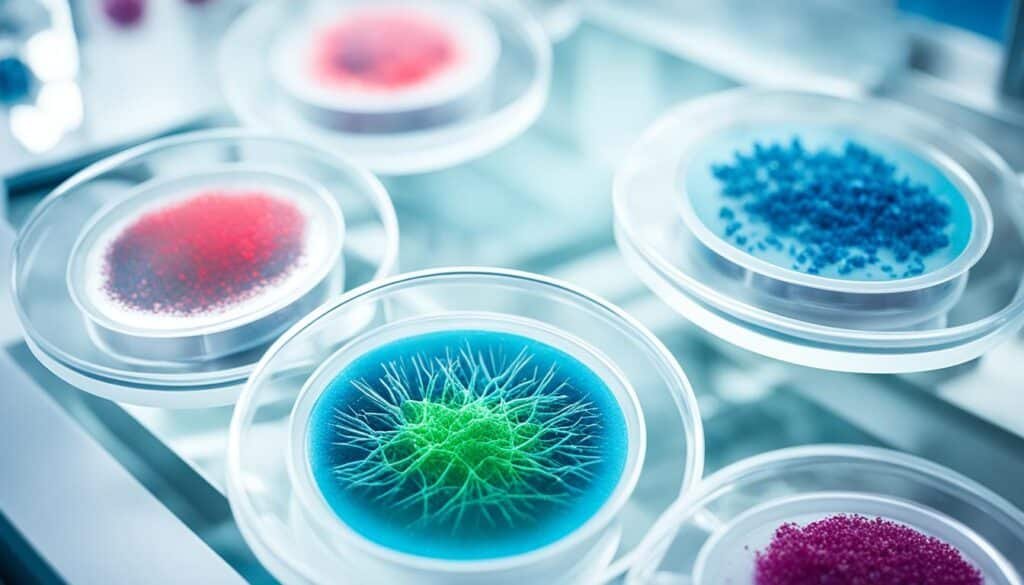Tissue Engineering Applications is at the forefront of regenerative medicine, offering innovative solutions for tissue regeneration and repair. By combining advanced biomaterial strategies with cutting-edge tissue engineering technologies, researchers and scientists are paving the way for groundbreaking treatments that address the growing need for regenerative approaches in healthcare.
In this article, we explore the exciting field of tissue engineering, focusing on the critical role of biomaterials and scaffold design. From the challenges of organ transplantation to the potential applications in various tissues, we delve into the latest advancements and future perspectives in tissue engineering.
Key Takeaways:
- Tissue engineering combines biomaterial strategies and tissue engineering technologies for tissue regeneration and repair.
- Biomaterials play a crucial role in providing a suitable environment for cell attachment and tissue growth.
- Scaffold design is essential for supporting tissue regeneration and ensuring appropriate mechanical properties.
- Tissue engineering has applications in bone, cartilage, cardiac, skin, and nerve tissue engineering.
- Advancements in tissue engineering offer exciting opportunities for personalized therapies and novel approaches to treat diseases and injuries.
Unmet Needs in Regenerative Medicine
The global population is currently facing a significant challenge due to the rising prevalence of chronic diseases and organ failure, primarily driven by factors such as aging. Conventional treatment options like immunization and antibiotics have proven inadequate in addressing these complex medical conditions. However, the field of regenerative medicine shows remarkable promise in offering innovative solutions to combat chronic diseases and organ failure. This approach focuses on utilizing regenerative techniques, including tissue transplantation, to treat and potentially reverse the effects of these debilitating conditions.
Despite the vast potential of regenerative medicine, there is a pressing unmet need for alternative approaches to organ transplantation. The demand for organs drastically exceeds the available supply, resulting in prolonged waitlists and limited treatment options for patients. Tissue engineering emerges as a viable solution to bridge this gap in organ transplantation, presenting an opportunity to revolutionize the field of regenerative medicine.
Addressing the Unmet Need
Regenerative medicine offers a novel approach to combat the rising burden of chronic diseases and organ failure. By harnessing the potential of tissue engineering, researchers and medical professionals can develop biological substitutes to replace and regenerate damaged or diseased tissues.
By overcoming the limitations of organ transplantation, tissue engineering provides an alternative solution that is not reliant on donor availability. Through the creation of lab-grown tissues or scaffolds, tissue engineering aims to replicate the structure and functionality of organs, allowing for transplantation without the need for organ donors.
The Role of Tissue Engineering
Tissue engineering utilizes biomaterials and scaffolds to facilitate tissue regeneration and repair. These materials act as a support system for cell growth and attachment, enabling the body to heal and restore tissue function naturally. Additionally, tissue engineering techniques can be combined with regenerative medicine approaches, such as stem cell therapy, to promote tissue growth and regeneration.
Tissue engineering has the potential to revolutionize the field of regenerative medicine by providing innovative solutions to address the unmet need for organ transplantation. By utilizing biomaterials and scaffolds, tissue engineering offers a unique approach to restore tissue function and improve the quality of life for patients with chronic diseases and organ failure.
Tissue Engineering Advancements and Future Outlook
Ongoing research and advancements in tissue engineering hold immense potential for the future of regenerative medicine. Scientists are exploring new techniques and technologies to enhance tissue engineering approaches, including precision engineering methods, in situ tissue engineering, and stem cell-based therapies.
Furthermore, the development of vascularization techniques aims to create a network of blood vessels within engineered tissues, improving their survival and integration within the recipient’s body. The use of bioreactors allows for the cultivation of functional tissues in vitro, paving the way for personalized medicine and the development of complex organs.
While challenges such as organ shortage, immune response, tissue integration, scaffold modification, and clinical translation persist, the continuous progress in tissue engineering offers exciting opportunities to overcome these obstacles and revolutionize the field of regenerative medicine.
Introduction to Tissue Engineering
Tissue engineering is an interdisciplinary field that combines principles from engineering and the life sciences to develop biological substitutes that restore, maintain, or improve tissue function.
It involves three main strategies: cell therapy, tissue inducing substances, and cell-matrix association.
Cell therapy involves the infusion of cells, such as stem cells, to treat injured tissues. By delivering cell population to specific areas in need of regeneration, the cells can replace damaged or lost tissue and stimulate healing.
Cell therapy holds significant potential in tissue engineering as it utilizes the regenerative capacity of cells to restore tissue function. Stem cells, in particular, have the ability to differentiate into various cell types, making them a valuable resource in regenerative medicine.
Tissue inducing substances refer to growth factors and small molecules, which can stimulate cell growth and tissue formation. These substances are introduced to the site of injury or regeneration to provide the necessary signals for cells to proliferate and differentiate.
By manipulating the chemical environment, tissue inducing substances can direct cells to form specific tissue types, facilitating the regeneration process.
Cell-matrix association focuses on the use of scaffolds or biomaterials to provide physical support and promote cell attachment and differentiation. The scaffold acts as a framework that guides cell growth and organizes the newly formed tissue.
Through the creation of a cell-friendly microenvironment, cell-matrix association facilitates the growth and development of functional tissue.
| Strategies in Tissue Engineering | Key Concepts |
|---|---|
| Cell Therapy | – Infusion of cells – Tissue regeneration – Stem cells |
| Tissue Inducing Substances | – Growth factors and small molecules – Cell growth and tissue formation |
| Cell-Matrix Association | – Scaffolds and biomaterials – Physical support – Cell attachment and differentiation |
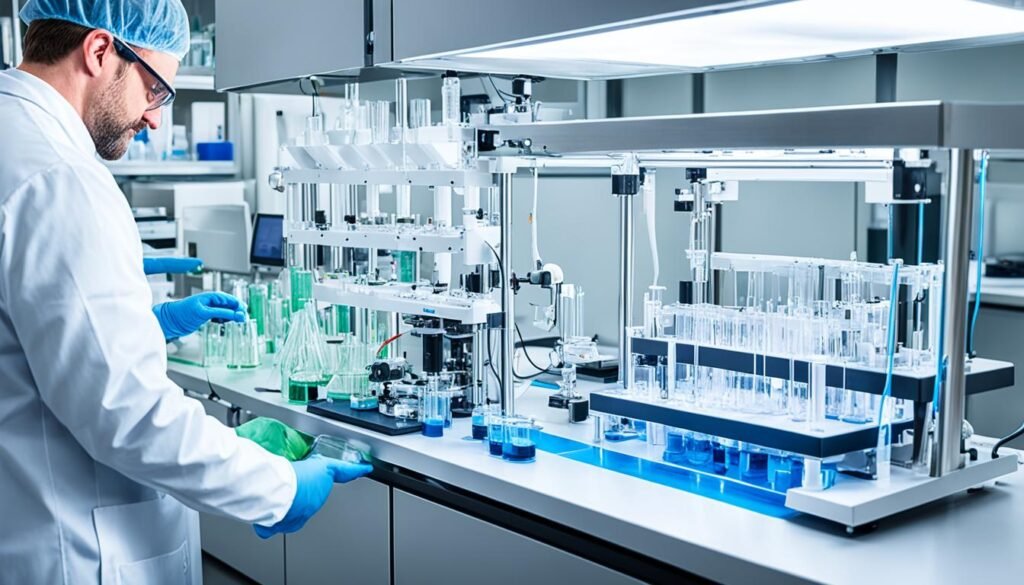
These strategies in tissue engineering enable researchers to manipulate cells and their microenvironment, allowing for the development of functional tissue substitutes. By harnessing the potential of tissue engineering, researchers strive to create biological substitutes that can restore tissue function and improve patient outcomes.
Biomaterials in Tissue Engineering
Biomaterials are essential components of tissue engineering that create an optimal environment for tissue regeneration. They are classified into various categories, including polymers, ceramics, metals, and composites. Polymers offer versatility due to their tunable properties and flexibility, making them suitable for a wide range of tissue engineering applications. Ceramics possess excellent biocompatibility and resemble the natural structure of bone, making them ideal for bone tissue engineering. Metals provide robust mechanical properties and are commonly used in load-bearing applications such as orthopedic implants. Composites, on the other hand, combine the unique properties of different biomaterials to enhance scaffold properties.
The choice of biomaterial depends on several factors, including biocompatibility, bioactivity, and biodegradability. Biocompatibility ensures that the biomaterial can interact with the host tissue without causing an adverse immune response. The biocompatibility of biomaterials is assessed through in vitro and in vivo testing to ensure their safety and compatibility with the human body. Bioactivity refers to the ability of a biomaterial to promote critical cellular processes such as adhesion, proliferation, and differentiation. It is crucial for achieving successful tissue regeneration and integration. Biodegradability is another essential characteristic, allowing the biomaterial to degrade over time and be metabolized and eliminated from the body, leaving behind regenerated tissue.
Polymeric biomaterials provide a wealth of possibilities in tissue engineering due to their versatility and suitability for various applications. The advances in polymer synthesis and processing techniques have enabled the development of biomaterials with tailored properties, such as mechanical strength, degradation rate, and bioactivity. These materials can mimic the natural extracellular matrix, guiding cell behavior and promoting tissue regeneration.
In context to biocompatibility, biodegradability, and bioactivity, it is crucial to select the appropriate biomaterial for each tissue engineering application. The table below provides an overview of these categories and their characteristics:
| Biomaterial Category | Characteristics |
|---|---|
| Polymers | Versatile, tunable properties, flexible |
| Ceramics | Excellent biocompatibility, bone-like structure |
| Metals | High mechanical strength |
| Composites | Combined properties of multiple biomaterials |
Thus, these biomaterials offer diverse options for scaffold design and tissue engineering applications, allowing scientists and researchers to create customized solutions for specific tissue regeneration needs.
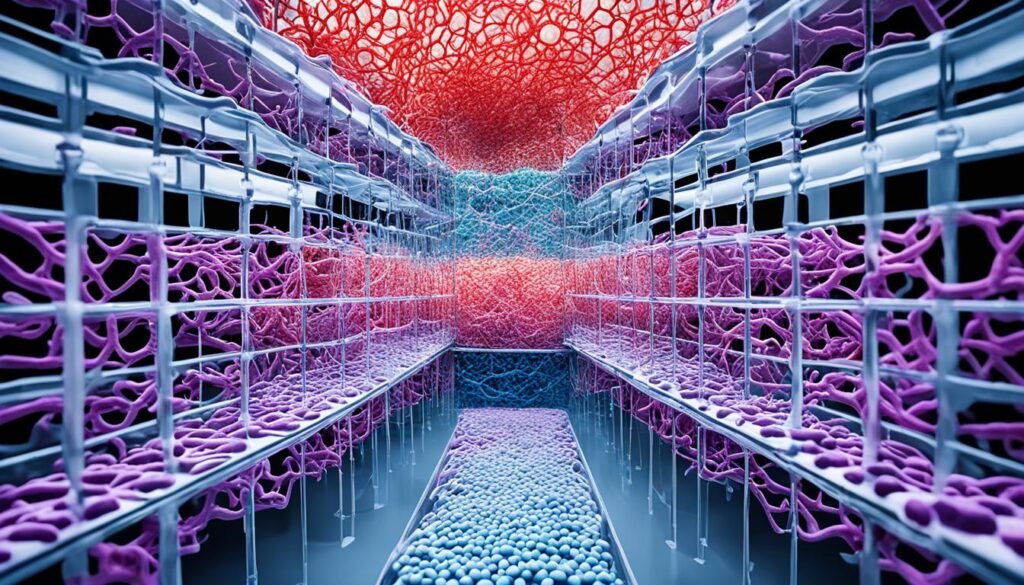
Scaffold Design in Tissue Engineering
Scaffold design plays a crucial role in the field of tissue engineering, as it provides a temporary 3D architecture that supports tissue regeneration. The design of a scaffold incorporates both macro-structural and micro-structural properties, ensuring an optimal environment for tissue growth and development.
Macro-structural properties refer to the overall structure and shape of the scaffold. This includes factors such as size, geometry, and overall architecture. These properties influence the overall functionality and performance of the scaffold in supporting tissue regeneration.
“The macro-structural properties of a scaffold are essential in determining its ability to mimic the native tissue and provide mechanical support.”
Meanwhile, micro-structural properties focus on the internal structure of the scaffold. These properties include the pore size, porosity, and interconnectivity within the scaffold. Pore size is important as it determines cellular penetration and nutrient diffusion throughout the scaffold, facilitating cell growth and tissue development.
“Micro-structural properties, such as pore size and porosity, play a critical role in promoting cellular infiltration, vascularization, and nutrient exchange within the scaffold.”
Another important consideration in scaffold design is the mechanical properties. Mechanical strength and stiffness are crucial in ensuring the scaffold’s ability to withstand physiological forces and provide structural support to the developing tissue. The scaffold should possess sufficient mechanical strength to prevent collapse or deformation during tissue regeneration.
“The mechanical properties of a scaffold directly impact its capacity to withstand mechanical loading and provide support to the growing tissue.”
Furthermore, porosity and pore size are essential factors in scaffold design. A scaffold should have an appropriate level of porosity, allowing cells and blood vessels to infiltrate the scaffold for tissue integration and functionality. Pore size also plays a role in controlling cellular behavior and guiding tissue development within the scaffold.
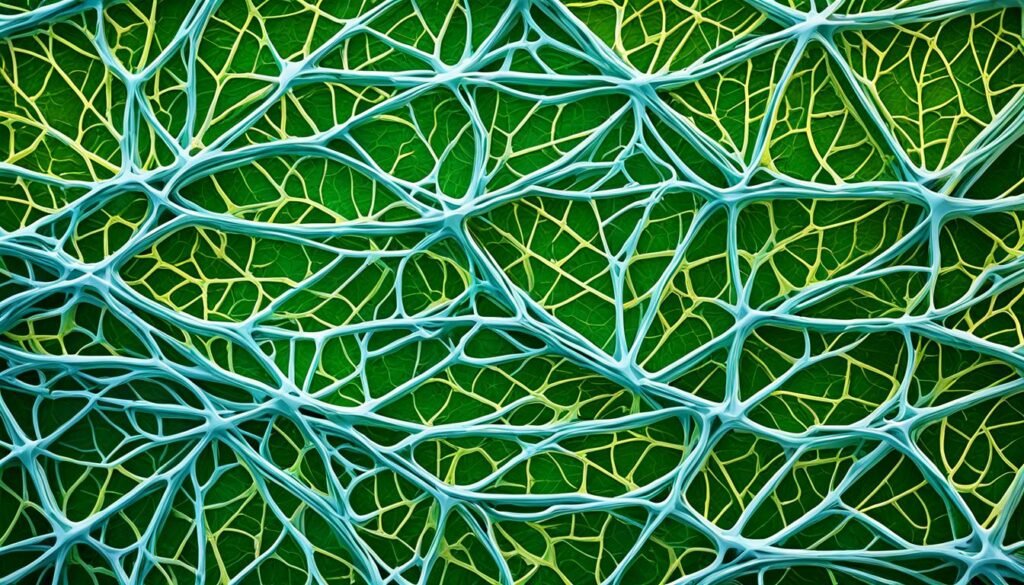
Comparison of Different Scaffold Design Properties
| Property | Description | Importance |
|---|---|---|
| Macro-structural properties | Overall structure and shape of the scaffold | Ensures mechanical support and mimics native tissue |
| Micro-structural properties | Pore size, porosity, and interconnectivity within the scaffold | Promotes cellular infiltration, vascularization, and nutrient exchange |
| Mechanical properties | Mechanical strength and stiffness | Provides structural support to the growing tissue |
| Porosity | Level of open space within the scaffold | Allows cell and blood vessel infiltration for tissue integration |
| Pore size | Size of individual pores within the scaffold | Controls cellular behavior and tissue development |
Overall, scaffold design is a critical factor in tissue engineering, influencing the success and efficiency of tissue regeneration. By carefully considering the macro-structural and micro-structural properties, as well as the mechanical strengths and porosity of the scaffold, researchers can create optimal environments for cellular growth, vascularization, and tissue integration.
Biomaterials for Scaffold Production in Tissue Engineering
Various biomaterials play a crucial role in scaffold production for tissue engineering applications. These biomaterials provide the necessary support and environment for tissue regeneration. Let’s explore some of the key biomaterials used in scaffold production:
Natural Polymers
Natural polymers, such as collagen and chitosan, are widely used in scaffold production due to their good biocompatibility and bioactivity. Collagen, the most abundant protein in the body, mimics the extracellular matrix and promotes cell attachment and growth. Chitosan, derived from crustacean shells, offers excellent biocompatibility and mechanical properties, making it suitable for various tissue engineering applications.
Synthetic Polymers
Synthetic polymers, like poly(lactic-co-glycolic acid) (PLGA) and polyethylene glycol (PEG), are commonly used in scaffold production. These polymers provide tunable mechanical properties and controlled degradation rates, allowing for customized scaffold design. PLGA is biocompatible and biodegradable, while PEG offers high water content and cellular compatibility, making them suitable for a wide range of tissue engineering applications.
Ceramics
Ceramics, such as hydroxyapatite and tricalcium phosphate, are widely used in bone tissue engineering due to their excellent biocompatibility and bone-like structure. These ceramics can promote osteoconduction and provide a favorable environment for bone regeneration. They are often combined with other biomaterials to enhance mechanical strength and overall scaffold properties.
Metals
Metals, including titanium and stainless steel, are used in scaffold production, particularly for load-bearing applications. These metals offer high mechanical strength and durability, making them suitable for bone and orthopedic tissue engineering. Surface modifications, such as coatings and porous structures, can enhance the biocompatibility and integration of metal scaffolds with surrounding tissues.
Composites
Composites combine the advantages of multiple biomaterials to enhance scaffold properties. For example, a composite scaffold may combine a natural polymer with ceramics or metals to achieve desired mechanical strength and biodegradability. Composites offer flexibility in scaffold design, allowing for the optimization of specific properties required for tissue engineering applications.
Hydrogels
Hydrogels, such as alginate and gelatin, are three-dimensional networks of hydrophilic polymers that mimic the extracellular matrix and offer high water content. These biomaterials provide a suitable environment for cell encapsulation and promote cellular interactions. Hydrogels are commonly used in tissue engineering applications where a soft and hydrated scaffold is desired, such as for cartilage tissue engineering or as a cell delivery vehicle.
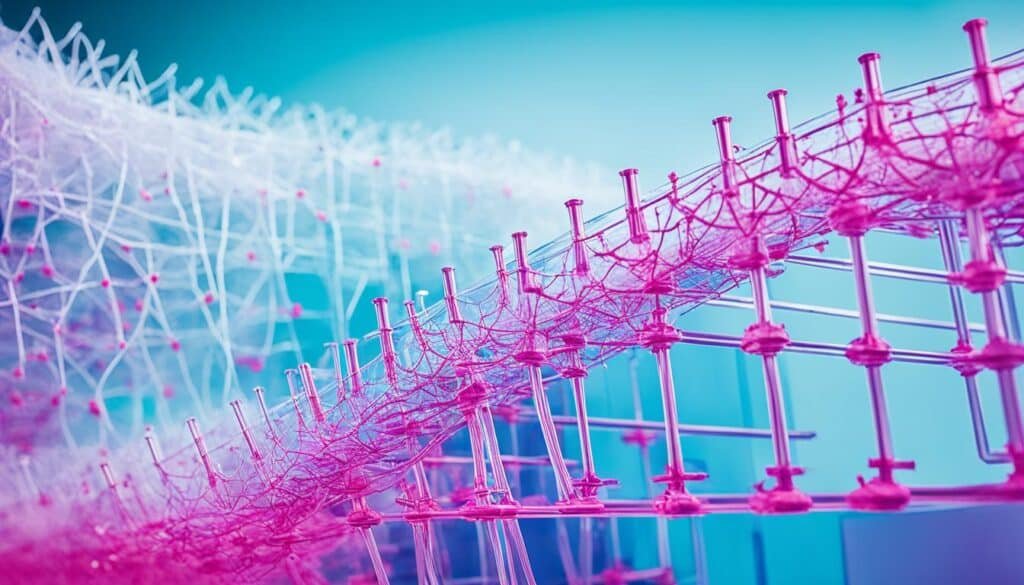
In scaffold production for tissue engineering, the choice of biomaterial depends on the specific tissue or organ being targeted, as well as the desired mechanical and biological properties. The use of biomaterials, such as natural polymers, synthetic polymers, ceramics, metals, composites, and hydrogels, allows for the fabrication of scaffolds that mimic the natural environment and stimulate tissue regeneration. By harnessing the potential of these biomaterials, researchers and scientists continue to advance the field of tissue engineering and bring us closer to the development of functional tissues and organs for therapeutic applications.
Tissue Engineering Applications in Different Tissues
Tissue engineering has revolutionized the field of regenerative medicine by offering diverse applications for various tissues. By employing innovative biomaterial strategies and scaffold design, tissue engineering has the potential to promote tissue regeneration and repair, providing solutions for a wide range of medical conditions.
Bone Tissue Engineering
In the field of bone tissue engineering, scaffolds play a crucial role in promoting bone regeneration and repair. These scaffolds provide a three-dimensional structure that supports the growth of new bone tissue. By incorporating biocompatible materials, such as polymers or ceramics, bone tissue engineering aims to restore the functionality of damaged or lost bone tissue.
Cartilage Tissue Engineering
Cartilage tissue engineering focuses on developing scaffolds for the repair and regeneration of cartilage in joints. With the help of biomaterials and scaffold design techniques, cartilage tissue engineering aims to address the challenges associated with cartilage injuries and degenerative diseases. By providing mechanical support and promoting cell growth and differentiation, these scaffolds hold the potential to restore cartilage functionality and alleviate pain.
Cardiac Tissue Engineering
With the aim of treating heart diseases, cardiac tissue engineering seeks to create functional cardiac tissue. By utilizing scaffolds and cell-based approaches, researchers are working towards generating myocardium-like tissues that can be integrated into damaged hearts, restoring their function. This innovative approach holds great promise for providing effective treatments for heart conditions and improving patient outcomes.
Skin Tissue Engineering
Skin tissue engineering utilizes scaffolds to promote skin regeneration and wound healing. By providing a suitable environment for cell attachment, proliferation, and differentiation, these scaffolds aid in the formation of new skin tissue. This approach has the potential to revolutionize the treatment of severe burns, chronic wounds, and other skin-related disorders.
Nerve Tissue Engineering
Nerve tissue engineering aims to regenerate damaged nerves and restore their functionality. Through the use of scaffolds and innovative cell-based approaches, researchers are working towards developing solutions for nerve injuries and disorders. This field holds great promise for providing effective treatments for conditions such as spinal cord injuries and peripheral nerve damage.
The development of tissue engineering applications in different tissues represents a significant advancement in the field of regenerative medicine. By leveraging biomaterials, scaffold design, and cell-based approaches, researchers are paving the way for innovative and personalized treatments for a wide range of medical conditions.

Advances in Tissue Engineering and Future Perspectives
Tissue engineering has witnessed significant advances in recent years, paving the way for innovative approaches in regenerative medicine. These breakthroughs hold immense potential for revolutionizing the field of tissue engineering and advancing the development of personalized therapies for various diseases and injuries.
“The field of regenerative medicine has flourished with remarkable advances in tissue engineering. These advancements have opened up new possibilities for regenerating tissues and organs, providing hope for patients suffering from debilitating conditions.” – Dr. Sarah Johnson, Tissue Engineering Expert
One of the notable advances is in situ tissue engineering, a technique that harnesses the body’s natural healing processes to regenerate tissues. Instead of creating tissue constructs in the lab for transplantation, in situ tissue engineering involves the delivery of bioactive materials, such as growth factors and stem cells, directly to the damaged site within the body.
Another key advancement in tissue engineering is the development of vascularization techniques. Vascularization, the formation of blood vessels within engineered tissues, is crucial for their long-term survival and functionality. Researchers have made significant strides in creating intricate networks of blood vessels, enabling better nutrient supply and waste removal within the engineered tissues.
Stem cell-based approaches have also emerged as a promising strategy for tissue regeneration. Stem cells have the remarkable ability to differentiate into various cell types, making them invaluable for repairing and regenerating damaged tissues. Scientists are exploring different sources of stem cells, such as embryonic stem cells, induced pluripotent stem cells, and mesenchymal stem cells, to tailor their use for specific tissue engineering applications.
“Stem cell-based therapies hold great potential for tissue engineering, as they offer the versatility to differentiate into the desired cell types required for tissue regeneration.” – Dr. James Anderson, Stem Cell Researcher
Bioreactors have transformed tissue engineering by allowing the cultivation of functional tissues in vitro. These devices provide the necessary mechanical and biochemical cues needed for cell growth, differentiation, and tissue development. Bioreactors enable the production of large quantities of engineered tissues, making them instrumental for clinical applications.
Precision engineering techniques have played a critical role in tissue engineering by allowing the fabrication of complex and tailored scaffolds. These scaffolds serve as temporary supports for tissue regeneration and mimic the native extracellular matrix. Precision engineering techniques enable precise control over the scaffold’s structure, mechanical properties, and bioactivity, leading to enhanced tissue integration and functionality.
Future Perspectives
The advancements in tissue engineering hold great promise for the future of regenerative medicine. Personalized medicine, with customized tissue engineering strategies tailored to individual patients, is fast becoming a reality. This approach offers the potential for more effective treatments, reduced rejection rates, and improved patient outcomes.
The development of novel therapies for various diseases and injuries is also within reach. Tissue engineering is poised to address unmet medical needs by providing solutions for tissue regeneration and organ replacement. The combination of advanced biomaterials, stem cell-based approaches, and precise scaffolding techniques will pave the way for groundbreaking treatments.
Current Challenges and Future Opportunities in Tissue Engineering
Despite the significant progress in tissue engineering, there are still challenges that need to be addressed. One of the major challenges is organ transplantation. The shortage of donor organs poses a significant obstacle in meeting the demand for organ transplantation. Additionally, the risk of immune response further complicates the success of organ transplantation.
Another crucial aspect that requires attention is tissue integration. The seamless integration of engineered tissues with the host tissue is essential for the success of tissue engineering applications. Researchers are focusing on developing scaffold modification techniques to improve tissue integration and enhance the functionality of engineered tissues.
Also Read:- Exploring The Aerospace Engineering Salary Range: What To Expect In The Field
Furthermore, the clinical translation of tissue engineering approaches faces challenges on regulatory and ethical fronts. There is a need to establish robust guidelines and frameworks to ensure the safe and ethical use of tissue engineering in a clinical setting.
However, these challenges also present exciting opportunities for the future of tissue engineering. Ongoing research and advancements in the field hold the potential to revolutionize regenerative medicine. By addressing these challenges, tissue engineering can provide innovative solutions for organ transplantation, enhance tissue integration, and pave the way for new therapies with strong clinical translation.
Conclusion
Tissue engineering combines innovative biomaterial strategies, scaffold design, and tissue regeneration techniques to develop biological substitutes for tissue repair and regeneration. Biomaterials play a crucial role in providing an optimal environment for cell attachment and tissue growth. Scaffold design is essential for supporting tissue regeneration and ensuring appropriate mechanical properties.
Although tissue engineering faces challenges such as organ shortage and the need for improved tissue integration, ongoing research and advancements offer exciting opportunities for the future of regenerative medicine. With an interdisciplinary approach and continuous development of tissue engineering strategies, biomaterials, and scaffold designs, personalized therapies and novel approaches to treat various diseases and injuries can be realized.
The future of tissue engineering holds great promise, with the potential to revolutionize the field of regenerative medicine. By harnessing the power of tissue engineering strategies, optimized biomaterials, and innovative scaffold designs, we can advance the field and make significant progress in tissue regeneration. Through continued research and collaboration, tissue engineering will pave the way for personalized treatments and contribute to the development of personalized medicine to improve the lives of patients worldwide.
FAQs
Q: What is tissue engineering?
A: Tissue engineering is a field that involves combining materials, cells, and biochemical factors to regenerate, repair, or replace damaged tissues in the body.
Q: How are stem cells utilized in tissue engineering and regenerative medicine?
A: Stem cells are often used in tissue engineering to help regenerate tissues and organs by differentiating into specialized cell types that are needed for repair.
Q: What are some common biomaterials used for tissue engineering applications?
A: Biomaterials such as nanofibrous scaffolds, collagen scaffolds, and polymers are frequently used for tissue engineering to provide structural support and guide tissue growth.
Q: Can tissue engineering strategies be applied in clinical settings?
A: Yes, tissue engineering strategies can have clinical applications by developing treatments for various medical conditions, injuries, and diseases through tissue regeneration.
Q: How do scaffolds play a role in tissue engineering?
A: Scaffolds in tissue engineering act as structures that support cell growth, provide a framework for tissue regeneration, and help in the formation of new tissues.
Q: What is the significance of regenerative engineering in the field of tissue engineering?
A: Regenerative engineering focuses on combining advanced materials and technologies with biological principles to develop new approaches for tissue repair and regeneration.
Q: What are the potential applications of polymers in tissue engineering?
A: Polymers are used in tissue engineering to create scaffolds, deliver bioactive molecules, and mimic the extracellular matrix, making them essential in designing biomaterials for tissue engineering applications.
Source Links
- https://www.intechopen.com/chapters/43781
- https://www.intechopen.com/chapters/65513
- https://www.ncbi.nlm.nih.gov/pmc/articles/PMC9512992/

